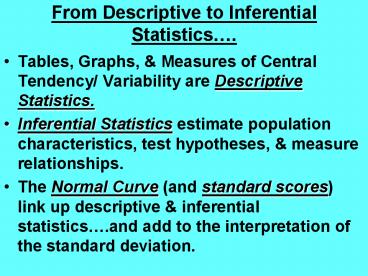From Descriptive to Inferential Statistics - PowerPoint PPT Presentation
1 / 38
Title:
From Descriptive to Inferential Statistics
Description:
'A poll found 31% of voters would support the Liberals if an election were held ... The remainder of those polled were undecided. ... – PowerPoint PPT presentation
Number of Views:237
Avg rating:3.0/5.0
Title: From Descriptive to Inferential Statistics
1
From Descriptive to Inferential Statistics.
- Tables, Graphs, Measures of Central Tendency/
Variability are Descriptive Statistics. - Inferential Statistics estimate population
characteristics, test hypotheses, measure
relationships. - The Normal Curve (and standard scores) link up
descriptive inferential statistics.and add to
the interpretation of the standard deviation.
2
(No Transcript)
3
Why is the normal curve so important in
statistics?
- A large number of real world variables are
normally distributed in samples populations. - The sampling distribution of several statistics
are normally distributed regardless of how the
variables are distributed in the population!! - The above theorem (Central Limit Theorem) is why
accurate inferences about populations can be made
from sample data.
4
Key aspects of the normal curve
- Normal curve is symmetrical or bell-shaped.
- Average (mean) is the most frequently occurring
value (mode), the value that splits the
distribution in half (median)so that 50 of the
cases have values greater than the mean, and 50
of the cases have values lower than the mean
(Mean Mode Median). - Assuming a variable is normally distributed we
can say more about the standard deviation.
5
If the mean IQ is 100 and the standard deviation
is 25, 34 of our 1000 cases (340 people) will
have IQs between 75 100 34 (340 people) will
have IQs between 100 125 and 68 (680 people)
will have IQs between 75 125.within 1
standard deviation of the mean.
6
If mean IQ is 100 standard deviation is 2513
of 1000 cases (130 people) have IQs between 125 -
150 (1 - 2 standard deviations above the mean).
A total of 47 (13 34) have IQs between 100
- 150 or up to 2 SDs above the mean. Likewise,
13 (130 people) have IQs between 75 - 50 or
between 1 and 2 SDs below the mean, 47 (470
people) have IQs between 50 - 100 or up to 2 SDs
below the mean. Finally, 95 (2 X 47) or 950
people have IQs within 2 SDs of the mean or
between 50 150.
7
Only 2.1 or 21 people have IQs between 150 175
(2-3 standard deviations above mean), while
another 2.1 or 21 people have IQs between 50
25 (2-3 standard deviations below mean). Adding
everything up (2.1 13.5 34.1 34.1 13.5
2.1) we can see that 99 of our sample of 1000
(999 people) have IQs between 25 175.or within
3 standard deviations of the mean IQ of 100!
8
The percentages associated with areas under the
normal curve can also be interpreted as
probabilities!!!
9
(No Transcript)
10
z standard score Xi any raw score or
value Xbar sample mean S sample standard
deviation
11
Why convert original values or scores on a
variable into standard scores?
- 1. Converting variable scores into standard
scores allows us to compare original scores from
different distributions. - 2. Converting variable scores into standard
scores allows us to express variable scores in
probabilities.
12
(No Transcript)
13
(No Transcript)
14
(No Transcript)
15
(No Transcript)
16
(No Transcript)
17
(No Transcript)
18
(No Transcript)
19
Statistical Estimation
- A poll found 31 of voters would support the
Liberals if an election were held today, 35
would vote for the Conservatives, 15 for the
NDP. The remainder of those polled were
undecided. The results are based on a sample of
1000 respondents and are accurate to within 5
percentage points 99 times out of 100.
20
- And surveys are not just limited to political
polling. A survey of sex in the U.S. found that - The average number of times per week that a
married couple have sex is 2.3 times per week.
The results are accurate to plus or minus .2 sex
acts 99 times out of 100.
21
- Survey research gets information from small,
representative samples to make accurate
generalizations about large populations..this is
statistical estimation. - The normal curve connects up descriptive and
inferential statistics. Fundamental inferential
statistics involve statistical estimation (e.g.,
estimating population proportions, percentages
means.using proportions, percentages means
obtained from small, representative samples.
22
(No Transcript)
23
(No Transcript)
24
(No Transcript)
25
(No Transcript)
26
(No Transcript)
27
(No Transcript)
28
(No Transcript)
29
(No Transcript)
30
(No Transcript)
31
From Estimation to Confidence Intervals.
- In repeated sampling, the distribution of means
is normally distributed with a mean equal to the
true population mean. - We can define a range of sample mean values
within which the true population mean is likely
to be estimate probability our range of sample
means includes the population meanthis is the
concept of the confidence interval.
32
(No Transcript)
33
(No Transcript)
34
(No Transcript)
35
(No Transcript)
36
(No Transcript)
37
(No Transcript)
38
(No Transcript)































